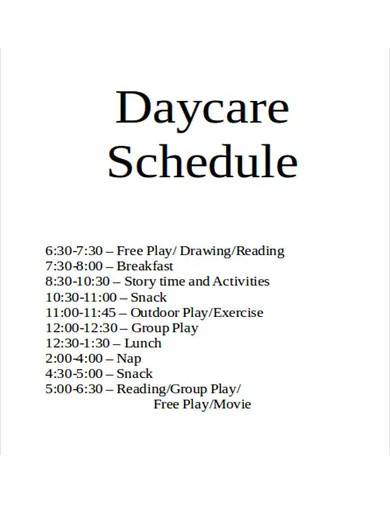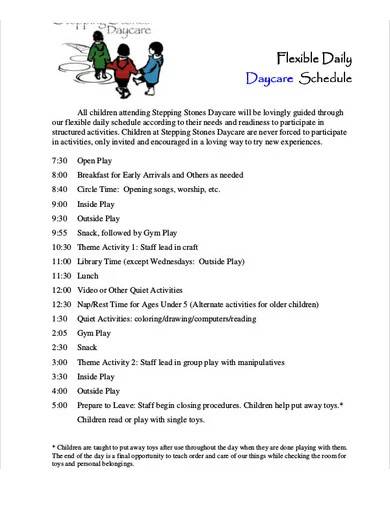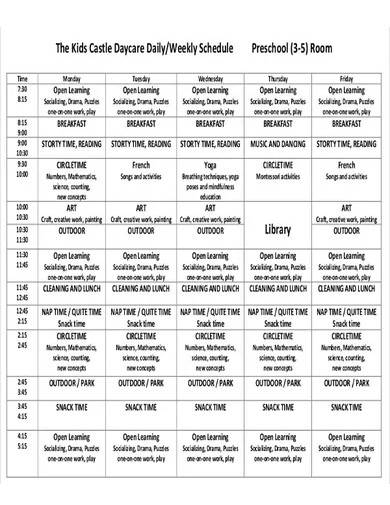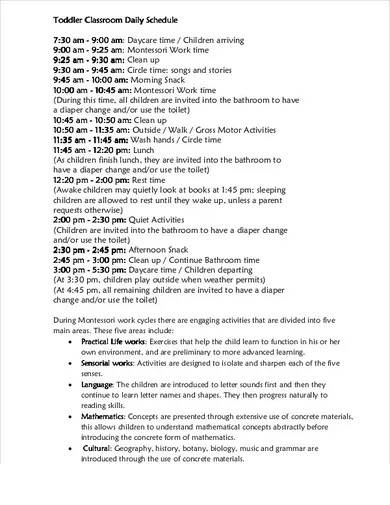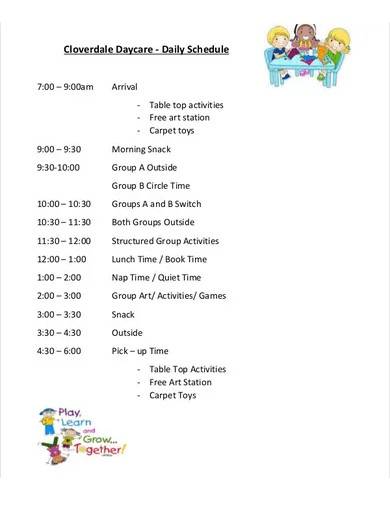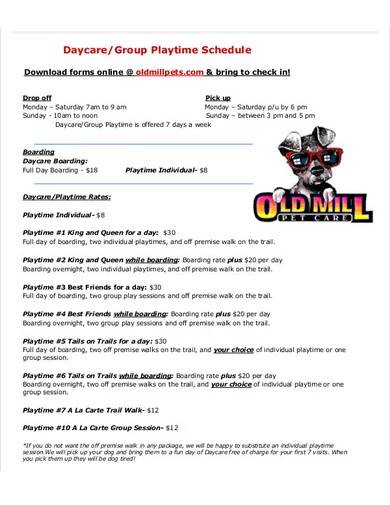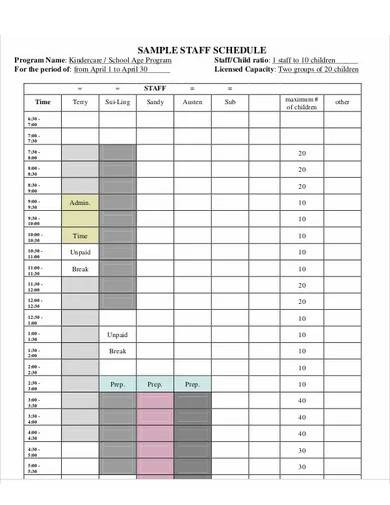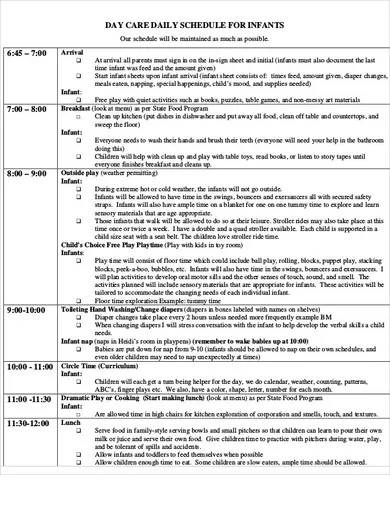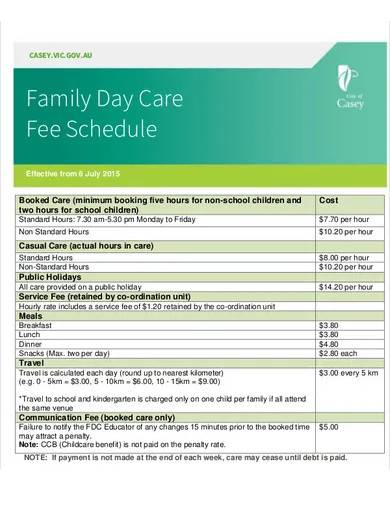Daycare is one of the several forms of preschool childcare programs that are designed to give children from families with busy schedules or low incomes an academic boost before kindergarten. Based on the book “Encyclopedia of Cross-Cultural School Psychology”, daycare is an educational care provided with supervision plus more active forms of instructional and social teaching paralleled by child development theory. If you’re planning to establish a home daycare business, one of the primary factors that you need to consider is having a daycare schedule. In this article, we have some downloadable daycare schedule samples to guide you. Keep on reading!
FREE 10+ Daycare Schedule Samples
1. Daycare Schedule Template
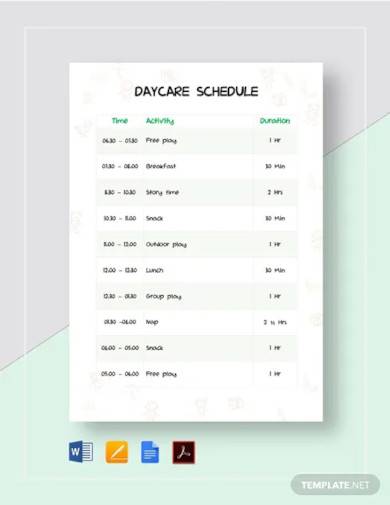
2. Baby Schedule Template
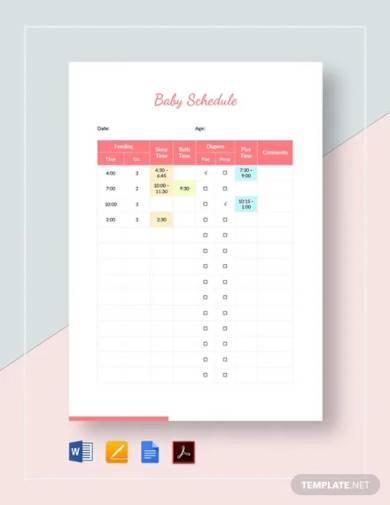
3. Sample Daycare Schedule
4. Daily Daycare Schedule
5. Daily/Weekly Daycare Schedule
6. Toddler Daycare Schedule Template
7. Sample Daily Daycare Schedule
8. Playtime Schedule Template
9. Daycare Staff Schedule
10. Baby Daily Daycare Schedule
11. Family Daycare Fee Schedule
What Is a Daycare Schedule?
Schedules are useful in organizing your activities, especially at work. The daily schedule you establish at your daycare will dictate your staff schedule. Most daycares open early and close late because they cater to working families. There are numerous ways to plan a day at your daycare. Some daycares schedule particular games, training sessions, or nap periods throughout the day. Other daycares use a basic routine without scheduled activity times.
How to Create a Daycare Schedule?
Creating a daycare schedule for infants and toddlers is a very integral part in running a childcare business. This tool enables you to stay organized and streamline your operations. In this way, you can manage your business well while providing support and convenience to your staff. Additionally, there are several general guidelines that you must follow in forming your schedule as it should incorporate ways to assess all of the social, emotional, and physical needs of the children in your daycare center. In this section, we are happy to give you some tips that can help you in making your home daycare schedule:
1. Acquire your licensing requirements
According to an article published by Brightwheel, being informed about the daycare and child care licensing regulations in your area is important as this will give you a foundation to begin with. For instance, what are the rules concerning the staff ratios for each age group at your daycare? Do you need to have a daily morning record of the health condition of your infants or toddlers? What are the guidelines regarding the appropriate nutrition of food served to your children? You must accomplish the mandatory requirements and recommended components prior to creating your daycare schedule.
2. Fill up your child’s developmental needs with various activities
Pamela May, the author of the book “Child Development in Practice: Responsive Teaching and Learning from Birth to Five”, explained that a rich learning environment provided for the infants and toddlers will see unexpected learning because young ones are learning from everything that happens to them. They have an increased recognition of every different thing. When little kids are playing, their learning ability is much likely to be unpredictable because the children’s minds are following their own distinct ideas.
Below are some samples of curriculum learning from some developmental activities:
- Birth to 11 months: Learn by observation about actions and their effects.
- 8-20 months: Have a strong exploratory impulse.
- 16-26 months: Express themselves through physical action and sound. Explore by repeating patterns of play.
- 30-50 months: Observe and use positional languages. Move freely with freedom and confidence in a range of ways, such as rolling, crawling, running, etc.
- 40-60 months: Interact with others, negotiate plans and activities, take turns in conversations.
Whether it’s hours of exercise per day or different kinds of play activities, all your daily daycare schedules should be made to fully support and enhance the developmental milestones of each age group as your aim is to prepare each child for progressing in the next developmental stage. Carefully include some structured routines and activities in your schedule which can fully benefit their physical, social, emotional, and cognitive skills and growth.
3. Add some transition times and flexibility
Based on an article written by Katelyn Vickers of HiMama, incorporating some transition times in between your scheduled activities. This helps the children to combine specific tasks with the activity they are about to participate in. Also, you can further prepare them for these transition times by constantly reminding them what’s the next activity or game.
Teaching toddlers to be more adaptable when something suddenly occurs is an important aspect in their development. So, try making small changes in your daycare schedule every once in a while. It’s like bringing some “pop of color” from your standard minimalist palette through adding a variety of tasks to your daily schedules. Doing this can contribute to their qualities later when they become older like building up strong resilience in life.
4. Consider your staffing needs
Your child care staff also need some regular break times throughout the day so that they can be more efficient and productive in all of their duties without any direct supervision like prep time, cleaning and organizing toys, etc.
FAQs
A daycare schedule helps you to have consistency in running your home daycare center. Having a well-prepared and balanced schedule that addresses primary developmental goals, allows you to provide families with excellent quality care. Also, having a consistent routine allows teachers to monitor each child’s progress, and coordinate with parents on daily care plans.What is the purpose of a daycare schedule?
The main factors to consider are the following:What are the main factors to consider in planning a daycare schedule?
Your first goal should be to provide the best child care for the families out there. Be aware of their necessities and familiarize yourself in your children’s overall well-being. Prioritize and fully equip their everyday needs. Focus on their basic learning skills and eventually help them to progress. Make it fun and avoid doing complicated things. How to create a daycare curriculum?
Have a comprehensive child care risk management plan and present this document to the respective parents or families. You should gain their trust and loyalty so that they can also be aware of their children being in good hands. How can I assure the families of the safety of their children in my daycare?
So, creating a simple daycare schedule is helpful in having a daycare business. Following a daycare schedule is very essential to install order in children’s lives. Being provided for regularly will significantly build a fundamental trust between the child and their caregiver. Performing daily routines ensures that children know their caregiver will be there to focus on any needs that appear. In turn, it gives stability and comfort to the child’s feelings toward their environment. We are happy to provide you some downloadable daycare schedule samples here in various formats. Simply click the templates in this article and start downloading now!
Related Posts
FREE 5+ Half Page Flyer Templates in PDF PSD | EPS
FREE 7+ Sample Plumbing Invoice Templates in PDF Excel | MS ...
FREE 12+ Rate Sheet Templates in PDF
FREE 9+ Sample Classroom Newsletters in PDF MS Word | PSD ...
FREE 36+ Examples of Termination Letter Templates in PDF MS ...
FREE 43+ Sample Employment Templates in MS Word PDF
FREE 8+ Best Preschool Newsletter Templates in MS Word PDF ...
FREE 37+ Sample Termination Letter Templates in PDF MS Word
FREE 9+ Sample Printable Preschool Worksheet Templates in MS ...
FREE 7+ Graduation Program Templates in PDF MS Word
FREE 31 Daily Log Templates in PDF MS Word
FREE 10+ HVAC Business Plan Templates in PDF MS Word
FREE 21+ Business Plan Samples in Ms MS Word PDF | Google ...
FREE 9+ Sample Training Request Forms in PDF
FREE 40+ Agenda Samples in MS Word PDF

